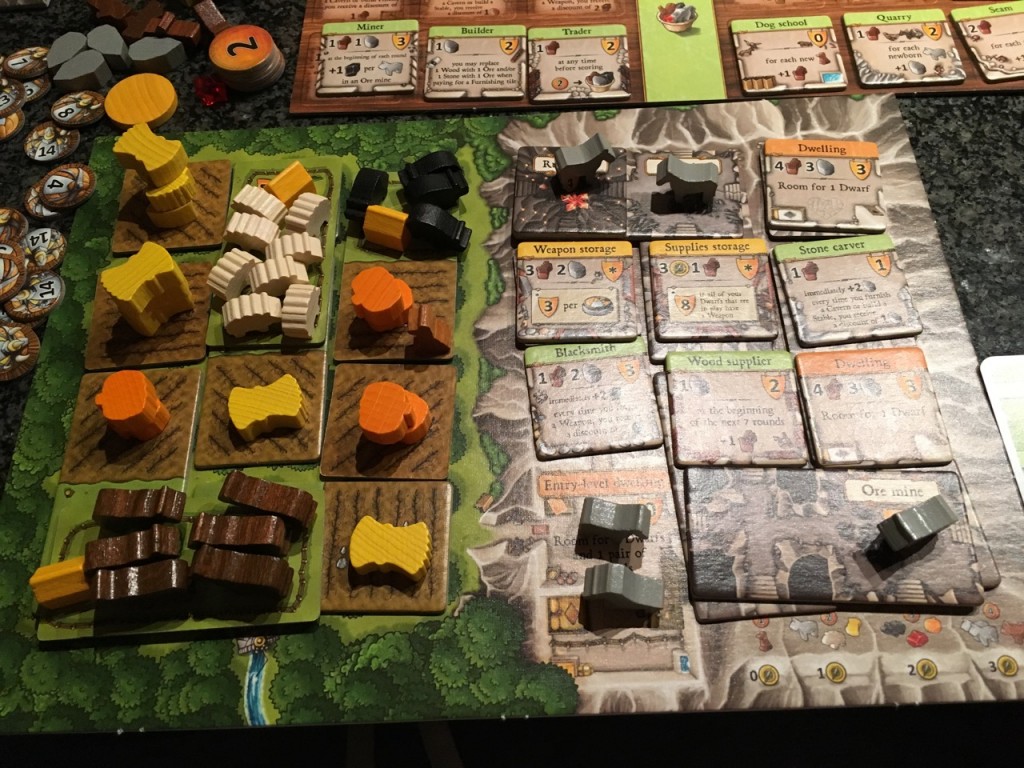
Just realized I haven’t blogged about “Caverna: The Cave Farmers” yet, the heaviest board game I’ve bought so far, literally. By Amazon it weights 7.8 pounds. It took me more than 20 minutes just to punch out all the tokens.
Caverna is basically an “Agricola 2.0”. If you’ve played Agricola before, you can easily find lots of similarities in Caverna. Fixed number of rounds, sowing vegetables and harvesting crops, feeding animals and turning your farm to a zoo, and of course, feeding your family and struggling on the line of starving. Hence, it’s pretty easy for Agricola players to learn Caverna despite the length of the rule book.
But after a few plays I noticed there were some obvious differences between Caverna and Agricola, which actually made a veteran Agricola player like me feel weird. It was not until almost 10 games that I started getting the hang of it.
The first impression of Caverna was everything goes faster, twice faster. In Agricola the game gets more and more going on later in the game, the Caverna the “game accelerating trajectory” is even more dramatic. For example, Slash and Burn (build a field and sow) is an end-game “power move” in Agricola, but in Caverna it’s available from the beginning. In Caverna, a high-level dwarf doing a 4-loot expedition feels like he can single-handedly turn the farm over in one day, which gives you an exciting feeling that is rarely found in Agricola. On this point, I like Caverna better.
Another great part of Caverna is it increased the strategy diversity. In Agricola almost every game and everyone aims for the same main route: building rooms and adding family members. The strategy variety in Agricola greatly depends on the career/development cards. In Caverna because of the introduction of Expedition and the general increase of action capabilities, the value of an action can be much more dramatically different, so a smaller family size is not necessarily a huge disadvantage, in some cases it could even be an advantage (your higher-level dwarf can act earlier). Scoring changes for family members also reduced the importance of having more family members. Considering a few other scoring and rule changes, I feel Caverna really enables more feasible strategies in the base framework of the game, instead of relying on a huge set of random cards.
Using a fixed set of Furnishing Tiles to replace career/development cards is a bold design. Agricola’s great replayability mainly comes from the random cards, which is a double-edge sword. A strong hand or just one or two combos can sometimes give a player unfair advantages in a game; and new players usually cannot figure out their cards well that either slow down the game or make their winning chance very dim. Therefore I definitely welcome a try for a more transparent and balanced mechanism to provide similar replayability. So far I have mixed feelings about Caverna’s Furnishing Tiles. They’re public information so when a new player is confused you can easily explain. However they don’t seem to be very well balanced as far as I can see. There are obviously strong tiles and almost useless ones. Maybe I haven’t experimented enough strategies to see more usefulness from some cards. Anyway it’s still better to have all Furnishing Tiles in a public market so any player can buy, so the imbalance introduced by drawing is eliminated.
Overall I recommend this game to people who like Agricola and would like to experience something similar and new. Have the expectation that you might be confused for a few games and won’t immediately enjoy it even if you know Agricola well. It’s a real v2.0, not a v1.1.